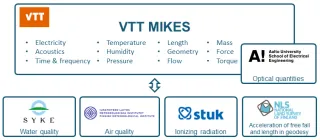SI system in Finland
The International System of units SI consists of a set of base units, derived units and prefixes. This article series provides basic information about the SI units and how they are realised in Finland.
The seven base units of the seven base quantities in the SI are:
| SI base unit | ||
| Base quantity | Name | Symbol |
| length | metre | m |
| mass | kilogram | kg |
| time | second | s |
| electric current | ampere | A |
| temperature | kelvin | K |
| amount of substance | mole | mol |
| luminous intensity | candela | cd |
The derived units can be formed by combining the base units according to the algebraic relations linking the corresponding quantities, for instance the SI coherent derived unit for density (mass density) is kg/m3. For some of the derived units a special name and special symbol is given, for instance, the derived unit for force is Newton, N (kg·m·s–2).
The SI prefixes are used to form decimal multiples and submultiples of SI units:
| Factor | Name | Symbol | Factor | Name | Symbol |
| 101 | deca | da | 10–1 | deci | d |
| 102 | hecto | h | 10–2 | centi | c |
| 103 | kilo | k | 10–3 | milli | m |
| 106 | mega | M | 10–6 | micro | µ |
| 109 | giga | G | 10–9 | nano | n |
| 1012 | tera | T | 10–12 | pico | p |
| 1015 | peta | P | 10–15 | femto | f |
| 1018 | exa | E | 10–18 | atto | a |
| 1021 | zetta | Z | 10–21 | zepto | z |
| 1024 | yotta | Y | 10–24 | yokto | y |
More information on
the International System of Units (SI): https://www.bipm.org/en/measurement-units/
More information about SI units
The National Measurement Standards System
The National Measurement Standards System realizes the International System of Units (SI) in Finland by maintaining and developing national measurement standards and offering services related to them. National measurement standards are maintained by National Standards Laboratories (NSL) for SI base and derived units in accordance with user needs. NSLs are required to ensure that each national measurement standard is metrologically traceable to the relevant SI unit definition either directly or via another internationally recognized measurement standard.
As the national metrology institute of Finland, VTT MIKES has the overall responsibility on the National Measurement Standards System and its development. As a National Standards Laboratory of its own, VTT MIKES also holds most of Finnish national standards related to physical quantities (electrical quantities, acoustics, time, frequency, length, geometrical quantities, temperature, humidity, pressure, flow, mass, force and torque). VTT MIKES has designated Metrology Research Institute of Aalto University as the NSL for optical quantities. Based on legislation, Radiation and Nuclear Safety Authority (STUK) acts as the NSL for ionizing radiation and Finnish Geospatial Research Institute (FGI) at National Land Survey acts as the NSL for length in geodesy and acceleration of free fall. In the field of chemical quantities, VTT MIKES has made contracts with Finnish Meteorological Institute (MIKES-FMI) for providing specific calibrations related to air quality measurements and Finnish Environment Institute (MIKES-SYKE) for providing specific chemical analyses of water samples.

The National Standards Laboratories perform scientific research, participate in international comparisons and other cooperation, and provide expert service within their scopes. The National Measurement Standards System is for providing calibration service to accredited laboratories and other users of high-accuracy measurements at the needed level.
All National Standards Laboratories and contract laboratories have joined as Designated Institutes the international arrangement CIPM MRA signed by VTT MIKES on behalf of Finland. Within this arrangement, all participants recognize measurement and calibration certificates issued by each other as far as they comply with the calibration and measurement capabilities (CMC) accepted to the KCDB (CIPM MRA database). The acceptance is based on peer review according to internationally agreed criteria. All Designated Institutes are also Associate Members of VTT MIKES within the European Association of National Metrology Institutes (EURAMET). As the national metrology institute, VTT MIKES oversees and guides the National Standards Laboratories and contract laboratories that are requested to comply with the requirements of legislation and international agreements (e.g. competence and quality system).
